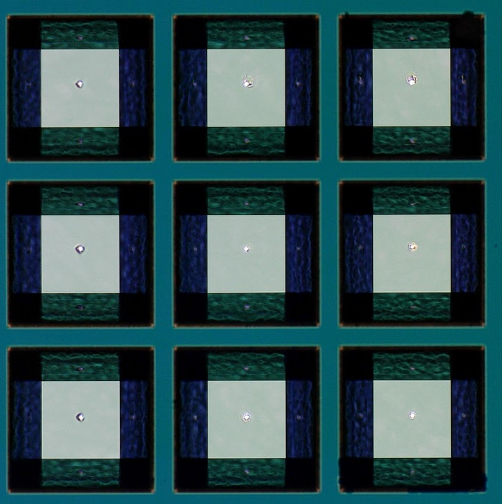Theory confirmed by research
It seems that we know everything about melting crystalline materials since it is one of the most frequently occurring phase changes involving transitioning from a solid into a liquid. However, that is not the case. WUT researchers are working on thorough research on the mechanisms of a crystalline-liquid phase transition.

A sample extract. The white dots in the middle of the light squares are holes formed after treating the layer with an X-ray pulse.
The WUT research team headed by Jerzy Antonowicz, PhD, DSc, Professor at WUT, faced such challenges since there is no definite experimental proof of theoretically predicted phenomena such as heterogeneous melting initiated on defects, homogeneous nucleation of a liquid in the crystal volume and kinetic parameters (the propagation speed of the melting front of the overheated crystal, among other things) known mainly from computer simulations.
The project, implemented within the competition for research grants Technologie Materiałowe-1, aimed to research the optically induced melting of palladium utilising the method of ultra-quick time-resolved X-ray diffraction using the radiation pulses generated by X-ray free-electron laser (XFEL).
The course of work
Measurements were taken during an experiment at the European X-Ray Free-Electron Laser Facility (European XFEL) - a part of a large-scale research collaboration of Professor Antonowicz with research teams from Poland, Germany, Japan, and the USA, among others, which has been underway for a couple of years.
“XFEL generates extremely short, bright, and highly energetic X-ray pulses, which can be used in pump-probe measurements. This method facilitates analysing phase changes occurring in a time scale of picoseconds, unattainable for conventional measurement methods,” says Professor Jerzy Antonowicz. “During the measurements taken at European XFEL, a thin layer of metal was excited with an optical pulse lasting a femtosecond, which caused local melting in the layer. A delayed sampling X-ray pulse was diffracted in the structure of the irradiated area of the layer, and the spatial distribution of diffuse radiation was registered as a two-dimensional diffractogram,” he adds.
First conclusions
The initial interpretation of research findings proved to be highly consistent with the theoretical predictions.
“Based on the quantitative analysis of diffraction data, we defined the relative content of crystalline and liquid phase and the size of crystalline grains during different melting stages, among others,” says Professor Antonowicz. “We concluded that the melting process occurs during approximately 10 ps after absorbing a femtosecond optical pulse. The analysis of the mean size of a crystalline grain shows that the melting starts in the unstructured areas of the grains whereas the propagation speed of the melting front reaches the range of 1000 m/s,” he adds.
Plans for the future
“Shortly, we would like to carry out large-scale computer simulations utilising the molecular dynamics method to confront later their results with experimental results,” says Professor Antonowicz. “We plan to expand our research by systems different from pure metals and time ranges amounting to nanoseconds, including the cooling and crystallization of a liquid, as well as transitioning of a cooled liquid into a solid omitting the crystallisation, which is the process of glass formation.”
Research team members:
Apart from the WUT applicants (Professor Jerzy Antonowicz, PhD, DSc; Adam Olczak, MSc), the research team involved in this project is a group of a few dozen people, both from Poland (Professor Ryszard Sobierajski’s team at the Institute of Physics at the Polish Academy of Sciences) and research centres in Germany, the USA, Great Britain, the Netherlands, Russia, and the Czech Republic.
The article was written based on the materials sent by Jerzy Antonowicz, PhD, DSc, Professor at WUT.

